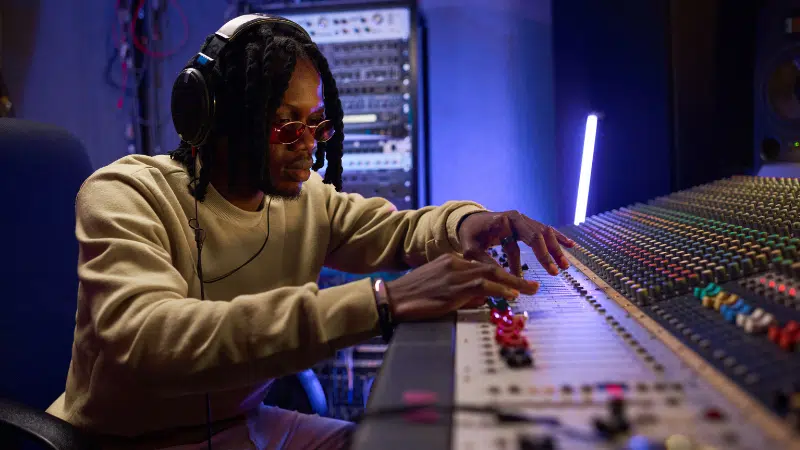Your label is an extension of your brand, and in this industry, how you show up online is a major part of the game. But with everything else you’ve already got on your plate, running the label, paying the bills, scouting new talent, and everything in-between… you’re supposed to manage social media, too? 😵💫📱 Before you start stressing, having a sustainable content strategy is the key. With it, you can highlight your roster, build your label’s identity, and connect with both fans and potential collaborators alike.
For indie labels especially, time is of the essence, and you don’t have time to waste on efforts that don’t pay off. In this post, we’ll show you how to set up a system that works with you, not against you. From defining your content pillars and organizing your ideas to the tools and systems that make everything as easy to manage as possible, here’s everything you need to know…
Content Strategy Tips for Indie Labels To Make Your Life Easier
Content Strategy for Labels vs. Artists
When people talk about content strategy, it’s usually from an artist’s perspective. They’re posting music, behind-the-scenes shots, personal updates to grow their fanbase, etc. For an independent label, though, it looks a little different. Your content isn’t just promoting one artist; it’s promoting your entire brand and roster, showing the world who you are, what you stand for, and why people should pay attention.
Think of your content strategy as a guideline for everything you post online. When it’s time to start thinking about what kind of content you need, keep these questions in mind:
👤 Who are you talking to? Fans, other artists, venues, or potential collaborators?
🎙️ What do you want to communicate? Are you highlighting new releases, sharing industry insights, showcasing artist spotlights, or giving a behind-the-scenes look at your label?
⏰ How often and where do you post? Scheduling consistently across platforms keeps your messaging professional and recognizable.
Unlike an artist’s strategy, which is more personal, centered around their music/individual story, your label strategy needs to juggle multiple artists, releases, and brand messaging, all without overwhelming your team. If you want everything to flow smoothly, things like planning monthly content themes, highlighting artists on a rotating schedule, or sharing regular label-branded updates keep things clear, easy to digest, and promote your label in a way that doesn’t feel forced.
As long as you’ve got a clear plan in place, you’ll not only save time but reduce stress for everyone involved while keeping everything as polished and intentional as possible. Now that you understand what makes a label’s content strategy unique, the next step is figuring out what your content should focus on.
Introducing… content pillars.
How To Define Your Label’s Content Pillars
Content pillars are essentially the main themes or categories that you want your label to consistently post about. These help you stay organized, make planning easier, and ensure your audience knows exactly what to expect from your brand. Think of them as the foundation of your content strategy. Everything you post should fit into at least one pillar. Here’s how to define yours:
- Start with your goals. What do you want your label to achieve with content? Are you trying to grow your fanbase, attract new artists, or build industry credibility? Your pillars should align with these goals.
- Look at your audience. Think about what your fans, artists, and collaborators want to see. What content will engage them most?
- Pick 3-5 pillars. Too many, and it gets overwhelming; too few, and your content feels repetitive. A manageable number keeps things consistent without being limiting.
- Map out example content. For each pillar, brainstorm a few post ideas. For example, some common pillars for independent labels include:
- Artist Spotlights: New release announcements, studio sneak peeks, mini interviews.
- Label Behind-the-Scenes: Team updates, day-in-the-life posts, studio sessions.
- Educational or Industry Content: Tips for independent artists, music industry news, trends, etc.
- Events and Announcements: Showcases, tours, label milestones.
- Test and refine. Track engagement and feedback. If a pillar consistently underperforms, tweak it or replace it with something more relevant.
Once you’ve defined your content pillars, the next step is figuring out when and how often to post each type of content. When you plan your posts weekly (or monthly), it’s so much easier to stay consistent and keep your audience engaged without stressing about what to post every time.
——
📚 Sharpen your skills…
SEO for Musicians: Why It Matters and How To Use It
How to Build Your Brand as an Independent Label
Smart Budgeting Basics for Indie Labels That Actually Work
How to Support Artist Mental Health as a Label or Manager
——
Planning Weekly/Monthly Content Themes
Now that you’ve defined your content pillars, you can organize them into a posting rhythm. Start by choosing a theme for the week or month. For example, you could dedicate one week to artist spotlights, another to label behind-the-scenes content, or focus an entire month on educational posts. This gives your content direction and makes scheduling things way easier.
Next, it’s time to decide which type of pillar content goes on which days. For example, you could do:
- Monday: New music announcements
- Wednesday: Artist spotlights
- Friday: Behind-the-scenes updates
Having a predictable schedule helps your audience know what to expect and keeps everything looking professional on your end. In addition, batching your content creation can save a ton of time, too. This means instead of creating posts one by one, plan multiple pieces in a single session, i.e., film a few artist interviews in one day or schedule several social media graphics at once. This method keeps your workflow efficient and prevents any last-minute stress.
Lastly, stay flexible! You never know when plans may need to shift when a new release, tour, or unexpected opportunity comes up. The goal is to have some structure without feeling too strict, so your content strategy works with the flow of whatever you need, whenever you need it.
Content Calendars and Scheduling Tools
Once you have your weekly or monthly themes mapped out, a content calendar is about to be your favorite tool ever. With it, you now have a central place to organize all your posts, keep track of deadlines, and make sure nothing falls through the cracks. To create one, you can use tools like Notion, Monday, or even just a simple Excel sheet to create a visual calendar where each post is tracked by date, platform, and pillar.
On top of that, scheduling tools can save you even more time. Platforms like Later and Buffer let you queue posts in advance across multiple social channels, so your content goes live automatically. This is especially helpful for indie labels juggling multiple artists and releases, since it keeps your presence consistent without requiring daily manual posting.
If you really want to make the most out of your calendar (and tools), try these tips:
- Color-code your pillars to make the schedule easy to scan.
- Include links, captions, and assets in your calendar to streamline posting.
- Set reminders for key dates like release days or events, so you never miss an important moment.
A well-organized calendar combined with scheduling tools keeps your content flowing smoothly. No stress or last-minute scrambling necessary.
📆 👀 Want to learn more about content calendar creation? How To Create a Social Media Content Calendar for Musicians offers a closer look (with examples!). Even though it’s geared toward artists, the steps can still apply to labels, too.
Delegating Tasks Across Your Team
If you’re running the label, managing social media probably isn’t at the top of your to-do list… and that’s okay! But someone on your team still needs to own it.
Start by figuring out who handles what. One person might manage posts, another creates graphics, and someone else tracks analytics. Artists can also contribute by providing behind-the-scenes photos, short videos, or personal updates for their spotlight posts. Once these roles are defined, your content calendar and scheduling tools become the backbone of keeping everyone on the same page. With these, you can set deadlines, attach assets, and leave notes for your team so they know exactly what’s expected and when. This makes the workflow smoother, reduces confusion, and ensures content stays consistent without relying solely on you.
💡 PRO TIP: Remember, splitting responsibilities isn’t just about divvying up the work; it’s about building a system where each person has defined ownership, clarity, and room to thrive in their role. If you want to dive deeper into splitting responsibilities within your label, we did a whole article that covers the ins and outs of this called How to Split Responsibilities Within Your Label to Build the Ultimate Team (thank us later).
To wrap things up…
Creating a sustainable content strategy isn’t about checking off every post or micromanaging every update that goes out. It’s about creating a system that works for everyone on your team (and the artists you represent). When everything is organized and planned in advance, posting consistently becomes not only manageable but even enjoyable. When your social media is run through premeditated systems you can count on, you can shift your focus to everything else on your plate and rest easy knowing your team (and your strategy) has your back.
Good luck!



